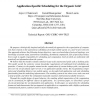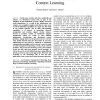954 search results - page 22 / 191 » Principles and Models for Organizing the IT Function |
CLUSTER
2004
IEEE
13 years 11 months ago
2004
IEEE
We propose a biologically inspired and fully-decentralized approach to the organization of computation that is based on the autonomous scheduling of strongly mobile agents on a pe...
CORR
2004
Springer
13 years 7 months ago
2004
Springer
Social insect societies and more specifically ant colonies, are distributed systems that, in spite of the simplicity of their individuals, present a highly structured social organi...
HICSS
2003
IEEE
14 years 27 days ago
2003
IEEE
Our “information-oriented” society shows an increasing exigency of life-long learning. In such framework, online Learning is becoming an important tool to allow the flexibilit...
AEI
2010
13 years 7 months ago
2010
nizing multiple forms of information and knowledge processing on different levels of abstraction in a structured and principled manner. We propose knowledge processing middleware a...
IDEAL
2005
Springer
14 years 1 months ago
2005
Springer
Recently, there has been a considerable research activity in extending topographic maps of vectorial data to more general data structures, such as sequences or trees. However, the ...


